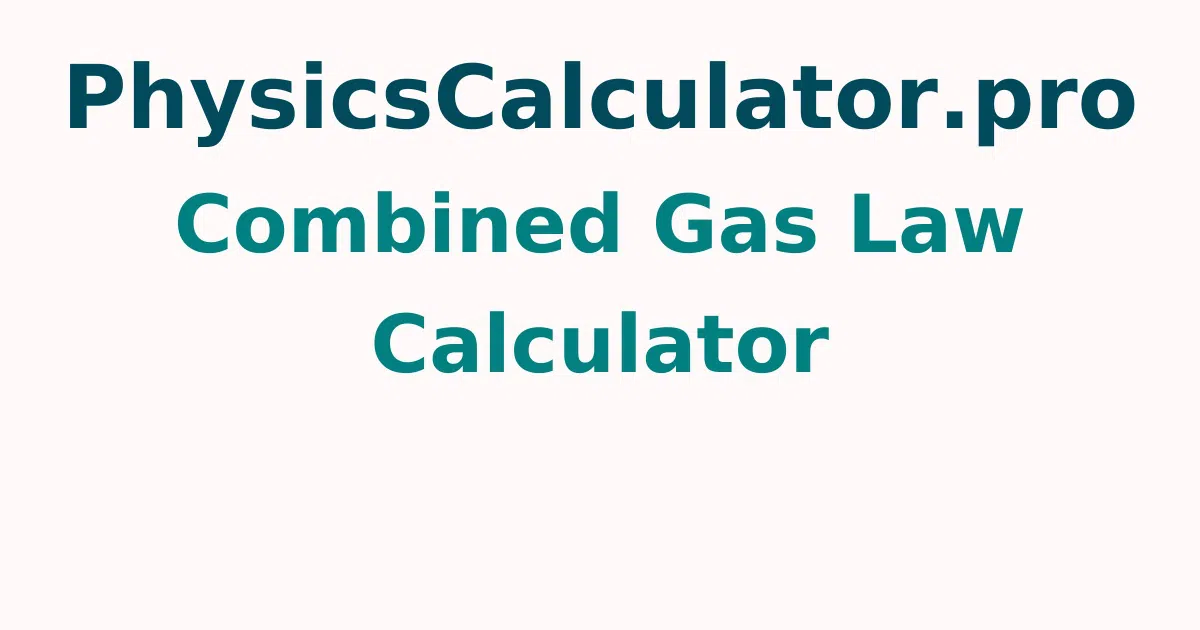Combined Gas Law Calculator
If you are about to use a handy tool for calculating the Combined Gas Law Parameters then you have come the right place. Just enter the inputs as specified in the calculator tool and click on the calculate button to get the output value in no time.
Combined Gas Law Formula
The combined gas law states that the temperature is proportional to the product of pressure and volume. Boyle's law, Charles law, and Gay-law Lussac's are integrated in combined gas law. The relationship between temperature, pressure, and volume is described by this law. The system remains constant in this situation.
The formula for the combined gas law is as follows: PV/T = k
- Here, k is Constant
- P is pressure
- V is Volume
- T is Temperature
In order to compute the changes in temperature, pressure or volume a sample gas may suffer in certain conditions, the combined gas law can be written as:
(P 1 *V 1 )/ T 1 =(P 2 * V 2 )/(T 2 )
- Where, The initial pressure be P 1
- The Final pressure be P 2
- The initial temperature be T 1
- The final temperature be T 2
- The initial volume be V 1
- The Final volume be V 2
The temperature is by default expressed in Kelvin but can also be specified in Celsius or in Fahrenheit, as the calculator applies the following rules to convert it to Kelvin:
- °C to K = t°C + 273.15
- °F to K = (t°F + 459.67)*5/9
You can checkout more concept with physicscalculatorpro.comto get quick answers by using this free tool.
How to use the Combined Gas Law Calculator?
The following shows about using the combined gas law calculator:
- To find the unknown value, enter the pressure, temperature, and volume in the input area.
- To get the unknown value, click the "Calculate" button.
- Finally, utilising the combined gas law, the unknown variable such as temperature, pressure, or volume will be displayed in the output field.
Combined Gas Law Examples
Question 1:If the initial and final volume is 98 m 3and 50m 3, final pressure is 73pa with the initial and final temperature is 55k and 65k then What will be the initial pressure?
Solution:
Consider the problem, we have
Let the Final pressure be P 2= 73 Pa
Let the initial temperature be T 1= 55 K
Let the final temperature be T 2= 65 K
Let the initial volume be V 1= 98 m 3
Let the Final volume be V 2= 50 m 3
The formula for finding the initial Pressure,(P 1 ) V 1 )/ T 1 ) =(P 2 * V 2 * /(T 2 )
P 1= 31.5149136577708 Pa
Therefore,The initial pressure of the Combined Gas Law: (P 1) = 31.5149136577708 Pa
FAQs on Combined Gas Law Calculator
1. State the combined gas law?
According to the combined gas law,The ratio between the product of pressure and volume and the temperature of a gas-based system remains constant.
2. Is the combined gas law inverse or direct?
When Boyle's law, Charles' law, and Gay-law Lussac's are combined, we get the combined gas law, which states that pressure is inversely proportional to volume, or that a larger volume equals a lower pressure. Temperature and pressure are directly related, therefore a higher temperature equals a higher pressure.
3. What is the purpose of this combined gas law calculator?
By combining the Charles and Henry Gas Laws, this Combined Gas Law Calculator can help you estimate the pressure, temperature, or volume of a gas.
4. What is the formula for calculating the combined gas law?
The Formula for calculate the Combined Gas Law is k=PV/T. So long as the number of moles in a gas remains constant, the constant k is a real constant. When the amount of gas changes, k changes as well.
